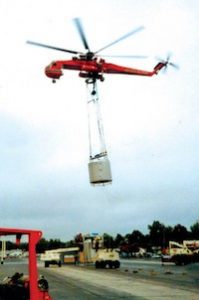Tips for Hiring An Industrial Rigging Construction Company
When it comes time to move industrial machinery, it can often take more than just a pallet jack or forklift. Manufacturing, production, and heavy machinery can sometimes weigh 10 to 20 tons or even more. But they can also be highly sensitive pieces of equipment with gauges or calibrated meters that must give very specific readings. Industrial rigging is an important part of the moving process and one of the most dangerous phases of any large-scale commercial construction project. Professional riggers are often called upon to safely lift and move unusual objects that are heavy, oversized, or situated in a tight spot.
Using a combination of equipment, riggers frequently relocate items such as:
- HVAC units
- Generators
- Printing presses
- Semiconductor equipment
- Mills
- Conveyors
- Safes
This job can’t be left to just anyone; an effective rigging team must understand the equipment being used, the full scope of the project, proper safety practices, and the permits and zoning requirements needed to carry out the job.
Rigging Services
Industrial rigging companies are used to move everything from delicate MRI machines to hydroelectric dam generators. Every move is different, presenting its own set of circumstances. However, riggers also work with crane operators to make sure loads are evenly packed and centered.
Here is a list of situations when an experienced rigger will be needed:
- Machinery Upgrades
- Plant Relocation
- Plant Reorganization
- Dismantling/Removal of decommissioned machinery
- Assembling/Installing new equipment
- Crane Rigging
Rigger Responsibilities
In a way, riggers are almost like boy scouts: They always have to be prepared. That means they need to be able to handle most situations that happen at the job site, but also the tools to help them handle it. Every crew on a rigging or construction project should have a box fully stocked with rigging equipment.
Wire Rope – Used in most lifting situations, whether it’s an all-terrain crane, a boom truck, or even an interior gantry lift. Wire rope is used because of its strength and flexibility. The wire rope connects the load to the lifting device. They may also be used to secure the load being lifted by the crane.
Canvas Straps – These are used to secure loads together to be lifted. These straps are ideal for odd or uneven loads because of its flexibility and ease of use. Canvas straps are rated for different load capacities.
Slings – Constructed of wire rope, canvas straps, or a combination of the two, slings provide two points of contact on larger, heavy objects.
Jacks – Just like jacking up a car to change a flat tire, jacks are used for lifting heavy equipment into place for moving.
Skates – To lift and move equipment when cranes aren’t available, skates are often used in conjunction with jacks. Just as the name implies, these are little platforms with wheels that make it possible to move large machinery by hand.
Turnbuckles – Used to take up the slack or apply tension to wire ropes. They usually use eyes, hooks, or shackles on either end.
Other items – This includes rigging safety gear like stop signs, orange vests, or even something as simple as caution cones. Dollies, large tools, or replacement parts should make up every good rigging box.
Inspections
While having the right rigging hardware is helpful, the most important part of safe rigging is inspecting the gear. Frayed wire rope or canvas strap should be removed from circulation. If slings appear damaged they should not be used. Even jacks that are working properly shouldn’t be used until they are in good working order.
As they say, the chain is only as strong as its weakest link.
Not all rigging companies are the same
It is critical to choose a service provider that’s right for you, rather than simply going with the lowest bidder. Despite many obvious similarities, one rigging company can differ greatly from another in terms of machinery, load capacities, manpower, and reputation as well as their range of services and support. When it comes to moving the infrastructure of your business, it’s vital to consult with a capable and experienced rigging company.
Find a rigging contractor who can do it all
Many professional industrial rigging companies not only provide equipment moving services but millwright services as well. In Storee’s case, we can offer every necessary service involved in a relocation, consolidation or start-up, including custom fabrication and any building modifications that may be necessary (and so often are).
This wide range of capabilities and experience enables us to provide the same level of quality and professional service from the initial plan and proposal to the final installation. We can promise an efficient, hassle-free and cost-effective equipment move.
And, because Storee has been an industrial facilities contractor for 50 years, you can trust us to leave you with a fully compliant building and an innovative plant layout that maximizes your production potential. Contact Storee for an equipment-moving consultation today. Call 888-736-2032 or email us at info@storee.com.

